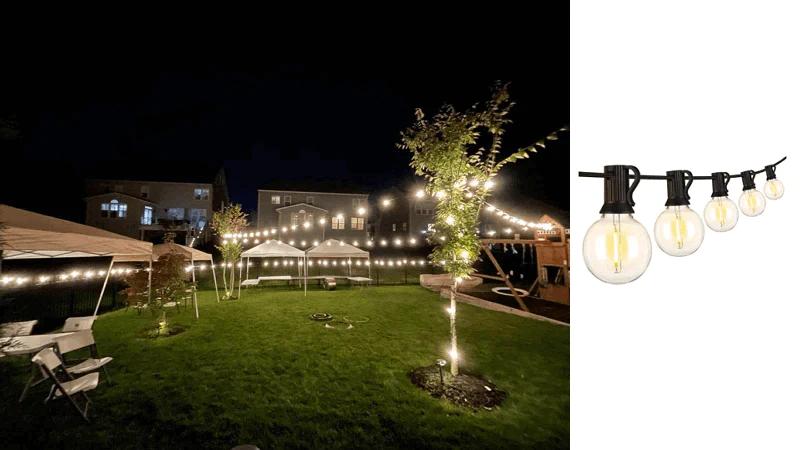Today, we’re going to transform your deck by adding a touch of magic with string lights. It’s such a simple and affordable update, but it can make your outdoor space feel so much more cozy and inviting.
So, let’s dive in, shall we?
Step 1: Plan it out
Before you begin, pop out to your deck and take a moment to decide how you want your lights to hang. If you have a wooden fence or gazebo-style ceiling to string lights across, you may not even need this guide. Some simple cup hooks can screw right into the wood, and you can string lights between them.
However, if you’re like me, you prefer the retro look of Edison-style bulbs hung on poles. It reminds me of old movie scenes set in Italian piazzas, where family and friends gather to dine under the stars. If that’s your vibe, then this guide is for you. But I’ll also include some tips at the end for people who want to string lights on deck railings or want to avoid using a drill.

For now? Let’s use poles to drape string lights high above your deck. This is a great method for those without a gazebo or railing. And if we do things right, it might just transform your deck into a vintage, Italian movie set!
Step 2: Determine your measurements
With your gorgeous plan in mind, now it’s time to measure the space. If you’re planning to drape the lights, make sure to measure the path they will take. This will help you determine how many sets of string lights you need.
How long should the poles be? That’s where your measuring tape comes in! With a friend’s help, hold your string lights high above your deck, at the top of your step ladder. You can place the step-ladder where a planter will be, at the far corner of your deck. Get a feel for how high you want the pole to be, and measure from there to the ground.
Remember, the pole should be high enough that the lights can dip in the middle. Our goal? Drape your ambient lights between the top of the pole (secured by a planter) and your home. We want them high enough so they don’t brush the heads of your guests, but low enough for you still to enjoy them!
Step 3: Gather your materials
To get started, you’ll need outdoor string lights; a measuring tape; outdoor extension cord (if your string lights aren’t long enough); tape measure; a ball of string; drill; two poles; zip ties (if you’re using metal poles); a plumb bob; fast-setting concrete; two, heavy-duty, sealed planters (so the cement doesn’t leak out); protective gloves and goggles; marker pen; a step ladder and a helpful friend. If you want your poles to match the color of your deck, you might want to bring along some spray paint or wood stain, also.
What sort of poles should you get? It all depends. If you use shepherd’s hook poles, you can create a gorgeous, old-fashioned look and even attach hanging baskets to them to accent the lights. The most important thing is to choose poles that can stand up to the outdoors: I recommend pressure-treated lumber or galvanized steel.
Using metal poles? Don’t forget to invest in some metal-ready bits for your drill (cobalt or high-speed steel works well). And if you want to add greenery to the top of the planters, you’ll need appropriate drill bits to make drainage holes (for example, use bits for tiles or glass if you aim to drill through ceramic).
Step 4: Use your muscles
Now for the heavy lifting! It’s time to position those two, sturdy planters at the far corners of your deck. Next, haul those poles into the garden. If you want them to match your deck, now is the time to lay down some old cardboard or newspaper, and spray-paint the metal, or stain the wood, so that whichever material of pole you’ve chosen looks great next to your deck.
Poles nice and dry? Great! Now, let’s get them ready to support the lights (it’s way easier to do this now, with the poles on the ground, instead of later, at the top of a ladder!)
Let’s say you’re using something like 4×4 wood for poles: You can screw in a cup hook by hand, or save some time by using a drill. What about metal poles? First, be sure to switch to a harder drill bit; you’ll still make a hole, but there’s no need for cup hooks: For metal poles, we’re going to use zip ties.
Step 5: Let’s get mixing
Now comes the fun part! If you’ve never mixed cement before, you’re in for a treat: There’s something satisfying about transforming powder into liquid into solid stuff that endures. Also, fast-setting concrete is the quickest and easiest way to make it happen.
Read the instructions on the back of your cement mix to work out what proportions you’ll need to fill pot number one. Look into your planter and decide how high you want the concrete to go to. If you aim to add dirt and plants on top (for the ultimate Italian piazza look!) then go ahead and mark a line inside the pot where the concrete should end and the soil begin.
Goggles out. Gloves on. Cement’s alkaline, so protect your eyes and hands! Where’s that friend who was helping you? Have them center the pole in the planter. Don’t forget, the end you drilled goes on top!
Now the magic of fast-drying cement is that you can pour the mix right into the planter, and just add water. And it only takes 20 minutes or so to set! Whip out your plumb bob to make sure that pole hardens perpendicular to the ground. Repeat with pot number two!
Step 6: Let’s get hanging
The moment has finally come. It’s time to hop up on your step ladder and drill some cup hooks into the side of your home (same height as the poles, and directly opposite each one). Now, you can finally start to drape those gorgeous string lights across your deck, moving from cup hook number one on your wall, out to pole number one, then across to pole number two, then back to your wall at cup hook number two.
Remember, if you’re using metal, there will be no cup hooks on the poles. In this case, just feed a zip tie through the hole we drilled, to secure the lights. Also, it helps to have your friend on board at this stage. One of you can hang, from up on the step ladder, while the other stands back to give the thumbs up when the level of dip in the string lights looks good.
Bonus: If you like, you can even add some dirt and plants to the top of the planters. This is a gorgeous touch for that retro, Italian-movie look. Just don’t forget to drill some discreet holes into the planters (just above the level of the concrete) so the water can drain. Since the soil will cover the concrete, you can even have your kids use a twig to carefully write their names, or even draw a picture, in the cement before it sets. They will love this! And it might just bring you joy when you rediscover it ten years later.
Step 7: You win
Welcome to Italy! It’s time to switch on your lights, pull up a chair, and enjoy your handiwork. This took some effort, but you’ve made your deck into a stunning space you can enjoy for years to come.
Share your pictures and stories below. I can’t wait to see what you made!
By the way, here are some other questions you might find useful:
How to hang string lights on deck railing
Simply drill cup hooks into your wooden railing and drape the lights between them (this makes the lights real easy to put up and take down).
How to hang string lights on a deck without drilling It is very simple: Just weave the string lights through the rails and around the top rail. Alternatively, you can use adhesive hooks (these work best on metal or concrete and won’t leave a mark.) One great brand option for this is outdoor Command hooks (which have water-resistant adhesion to withstand the elements). You can also experiment with alumahooks or awning hangers, which rely on slotting into grooves or awnings instead of adhesion.
How to hang string lights on metal deck railing
You can drill into the metal with a very hard drill bit (cobalt or high-speed steel), then feed zip ties through to secure the lights. Alternatively, you can use one of the non-drilling methods mentioned above (adhesive hooks, alumahooks, awning hangers, or simply weaving the lights through the rails).
See you next time!


